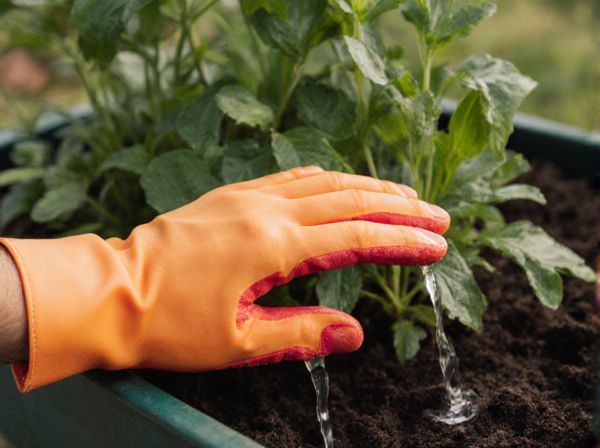
Pre-soaking vs Dry Planting Illustration
Pre-soaking seeds accelerates germination by softening the seed coat and activating metabolic processes, leading to faster and more uniform sprouting compared to dry planting. Dry planting relies on natural soil moisture to initiate germination, which can result in slower and less predictable seedling emergence. Choosing pre-soaking is especially beneficial for hard-coated or larger seeds that require more time to absorb water.
Table of Comparison
| Aspect | Pre-soaking | Dry Planting |
|---|---|---|
| Germination Speed | Faster germination by softening seed coat | Slower germination due to natural seed hydration |
| Water Absorption | Seeds absorb water before planting | Seeds rely on soil moisture after planting |
| Success Rate | Higher germination success in dry or tough seeds | Variable success depending on soil conditions |
| Preparation Time | Requires advance soaking (usually 12-24 hours) | No pre-planting preparation needed |
| Suitable Seed Types | Hard-coated or slow-germinating seeds | Seeds with thin coats and fast germination |
| Risk of Rot | Increased if soaking time is excessive | Lower risk if soil drainage is adequate |
Understanding Seed Germination: Basics and Importance
Pre-soaking seeds enhances germination by softening seed coats and accelerating water absorption, promoting faster and more uniform sprouting compared to dry planting. Dry planting relies on natural soil moisture but may result in slower or uneven germination due to variable water availability. Understanding these differences is crucial for optimizing seedling establishment and improving crop yield outcomes.
What is Pre-soaking? Science and Method
Pre-soaking seeds involves immersing them in water for a specific duration to accelerate germination by softening the seed coat and activating enzymatic processes. Scientifically, this method increases water uptake, promoting the metabolic activities necessary for embryo growth. Typically, seeds are soaked for 6 to 24 hours in room temperature water before being planted to enhance uniform sprouting and improve overall germination rates.
Dry Planting Explained: Approach and Benefits
Dry planting involves sowing seeds directly into dry soil without pre-soaking, allowing natural moisture from rainfall or irrigation to trigger germination gradually. This approach minimizes the risk of seed rotting and fungal infections, making it ideal for tough or hard-coated seeds. Dry planting also promotes stronger root development as seedlings emerge more resiliently from slower, natural hydration processes.
Seed Viability: Effects of Pre-soaking vs Dry Planting
Pre-soaking seeds enhances germination rates by softening seed coats and accelerating water absorption, which improves seed viability compared to dry planting. Dry planting can lead to slower germination and lower overall viability due to delayed moisture uptake and potential seed desiccation. Research indicates pre-soaked seeds exhibit higher emergence percentages and more uniform seedling development.
Germination Rates: Comparative Analysis
Pre-soaking seeds significantly enhances germination rates by softening seed coats and activating metabolic processes, often resulting in a 20-30% increase compared to dry planting. Dry planting can delay germination as seeds remain dormant until sufficient moisture is absorbed from the soil. Studies reveal that pre-soaked seeds typically germinate within 3-5 days, whereas dry planted seeds may take 7-10 days, highlighting the efficacy of pre-soaking in accelerating early plant development.
Plant Species Suitability: Which Method Works Best?
Pre-soaking seeds generally benefits species with hard seed coats, such as beans, peas, and many trees, by softening the coat and accelerating germination. Dry planting suits species with thin or delicate seed coats like lettuce, carrots, and many wildflowers, as soaking can cause seed rot or premature sprouting. Selecting the method based on seed coat hardness and natural germination triggers optimizes success rates across diverse plant species.
Step-by-Step Guide: How to Pre-soak Seeds
Pre-soaking seeds involves immersing them in water for 8 to 12 hours to soften the seed coat and accelerate germination by promoting moisture absorption. After soaking, drain the seeds and plant them immediately in a well-prepared soil bed or seed tray with optimal temperature and light conditions. This method enhances germination rates compared to dry planting, especially for hard-coated seeds like beans, peas, and certain flower species.
Common Mistakes in Pre-soaking and Dry Planting
Common mistakes in pre-soaking seeds include soaking for too long, which can cause seed rot, and using water that is too cold, slowing germination. In dry planting, errors often involve planting seeds too deep or in soil that is not adequately moist, leading to poor seedling emergence. Both methods require careful attention to seed type and environmental conditions to optimize germination success.
Environmental Factors: Impact on Germination Success
Pre-soaking seeds enhances germination success by ensuring optimal moisture availability, especially in arid or fluctuating environmental conditions, which accelerates seed metabolic activities. Dry planting depends heavily on immediate rainfall or soil moisture, making it less reliable in unpredictable climates or drought-prone regions. Temperature and soil aeration interact with moisture levels to determine seed viability, where pre-soaking can mitigate adverse environmental stressors and improve early seedling establishment.
Expert Tips: Choosing the Right Method for Your Garden
Pre-soaking seeds accelerates germination by softening the seed coat, which is especially beneficial for hard-coated varieties like beans and peas, while dry planting suits seeds with naturally thin coats such as carrots and lettuce. Experts recommend pre-soaking in lukewarm water for 12-24 hours to maximize moisture absorption without causing rot, enhancing uniform sprouting rates. Selecting the right method depends on seed type, soil conditions, and climate; leveraging seed packets and horticultural databases ensures optimal germination outcomes for diverse garden environments.
Pre-soaking vs Dry Planting Infographic

 gardendif.com
gardendif.com